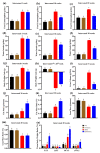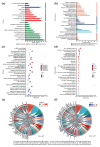(-)-Gallocatechin Gallate Mitigates Metabolic Syndrome-Associated Diabetic Nephropathy in db/db Mice
- PMID: 38890983
- PMCID: PMC11171689
- DOI: 10.3390/foods13111755
(-)-Gallocatechin Gallate Mitigates Metabolic Syndrome-Associated Diabetic Nephropathy in db/db Mice
Abstract
Metabolic syndrome (MetS) significantly predisposes individuals to diabetes and is a prognostic factor for the progression of diabetic nephropathy (DN). This study aimed to evaluate the efficacy of (-)-gallocatechin gallate (GCG) in alleviating signs of MetS-associated DN in db/db mice. We administered GCG and monitored its effects on several metabolic parameters, including food and water intake, urinary output, blood glucose levels, glucose and insulin homeostasis, lipid profiles, blood pressure, and renal function biomarkers. The main findings indicated that GCG intervention led to marked improvements in these metabolic indicators and renal function, signifying its potential in managing MetS and DN. Furthermore, transcriptome analysis revealed substantial modifications in gene expression, notably the downregulation of pro-inflammatory genes such as S100a8, S100a9, Cd44, Socs3, Mmp3, Mmp9, Nlrp3, IL-1β, Osm, Ptgs2, and Lcn2 and the upregulation of the anti-oxidative gene Gstm3. These genetic alterations suggest significant effects on pathways related to inflammation and oxidative stress. In conclusion, GCG demonstrates therapeutic efficacy for MetS-associated DN, mitigating metabolic disturbances and enhancing renal health by modulating inflammatory and oxidative responses.
Keywords: GCG; diabetic nephropathy; metabolic syndrome; renal transcriptome analysis.
Conflict of interest statement
The authors affirm that there are no competing interests to disclose.
Figures






Similar articles
-
Gallic Acid Alleviates Glucolipotoxicity-Induced Nephropathy by miR-709-NFE2L2 Pathway in db/db Mice on a High-Fat Diet.J Agric Food Chem. 2024 Oct 4;72(41):22645-60. doi: 10.1021/acs.jafc.4c05898. Online ahead of print. J Agric Food Chem. 2024. PMID: 39365293 Free PMC article.
-
PS-MPs promotes the progression of inflammation and fibrosis in diabetic nephropathy through NLRP3/Caspase-1 and TGF-β1/Smad2/3 signaling pathways.Ecotoxicol Environ Saf. 2024 Mar 15;273:116102. doi: 10.1016/j.ecoenv.2024.116102. Epub 2024 Feb 21. Ecotoxicol Environ Saf. 2024. PMID: 38382346
-
A small molecule inhibitor MCC950 ameliorates kidney injury in diabetic nephropathy by inhibiting NLRP3 inflammasome activation.Diabetes Metab Syndr Obes. 2019 Aug 2;12:1297-1309. doi: 10.2147/DMSO.S199802. eCollection 2019. Diabetes Metab Syndr Obes. 2019. PMID: 31447572 Free PMC article.
-
Prevalence and Management of Diabetic Nephropathy in Western Countries.Kidney Dis (Basel). 2015 May;1(1):61-70. doi: 10.1159/000382028. Epub 2015 May 1. Kidney Dis (Basel). 2015. PMID: 27536666 Free PMC article. Review.
-
The Prevalence and Management of Diabetic Nephropathy in Asia.Kidney Dis (Basel). 2015 May;1(1):52-60. doi: 10.1159/000381757. Epub 2015 Apr 30. Kidney Dis (Basel). 2015. PMID: 27536665 Free PMC article. Review.
Cited by
-
Relationship between dietary flavan-3-ols intake and mortality in metabolic syndrome population; a large cohort study.Front Nutr. 2025 Apr 10;12:1572189. doi: 10.3389/fnut.2025.1572189. eCollection 2025. Front Nutr. 2025. PMID: 40276531 Free PMC article.
References
Grants and funding
LinkOut - more resources
Full Text Sources
Research Materials
Miscellaneous

